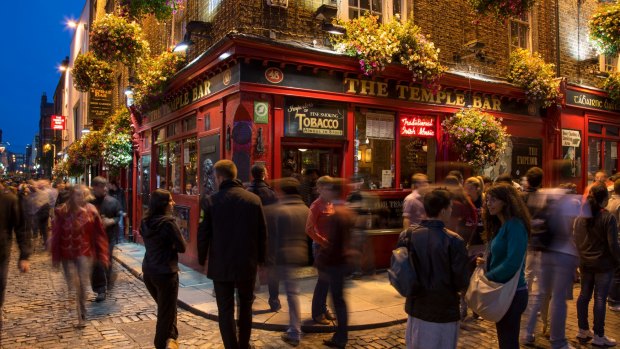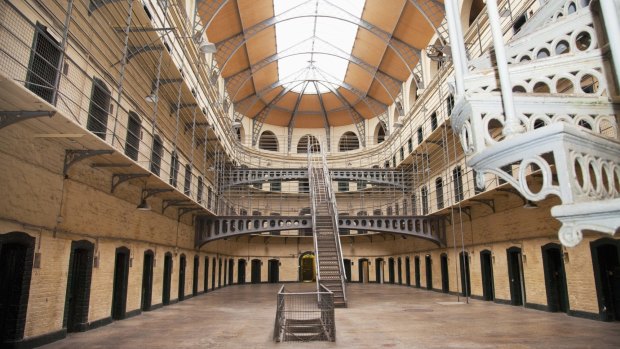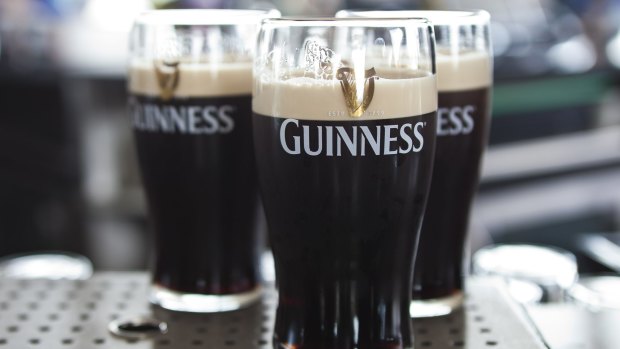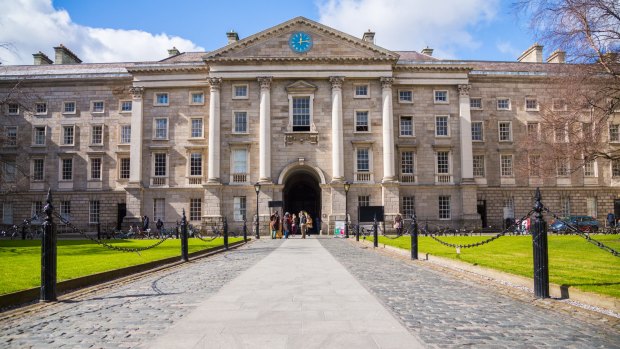This was published 8 years ago
Dublin, Ireland: 20 reasons to visit the home of Guinness beer

Dublin famed Temple Bar pub district at night.Credit: Getty Images
1. VISIT: TRINITY COLLEGE
The full name of Trinity College, which sits like a fort in the middle of town, is College of the Holy and Undivided Trinity of Queen Elizabeth near Dublin. Such an ostentatious title has a lot to live up to, but Trinity is the kind of university that romantic academics swoon over. A series of interior squares are surrounded by graceful buildings, including the Campanile, a 30-metre granite bell tower. But the real attraction is the library with its 5 million books. The Long Room is a sight to behold, and no visit is complete without glimpsing of the Book of Kells, an extraordinary illuminated manuscript of the holy Gospels. See www.tcd.ie
2. IMBIBE: GUINNESS STOREHOUSE

Kilmainham Gaol, Dublin.Credit: Getty Images
When Arthur Guinness began selling his dark and unusually thick porter in 1778 –– the year, incidentally, the First Fleet landed in Botany Bay – he couldn't have guessed how legendary his stout would become. Today Guinness is one of the most popular beers in the world, and its spiritual home is the Guinness Storehouse. While its questionable whether any beer really needs a seven-floor emporium of tasting rooms and interactive history exhibitions, the Gravity Bar is worth a visit for its view over Dublin's rooftops. See www.guinness-storehouse.com
3. VISIT: OLD JAMESON DISTILLERY
Less hectic than the Guinness Storehouse, the Old Jameson Distillery near Smithfield Square is called "old" because it's the site of original fermentation vats (look down through the glass floor). It closed in 1971, with production moved to Midleton, but today a museum offers interesting guided tours that unpack the arcana of creating a perfect whiskey. Tours include tastings, of course, so don't count on driving anywhere afterwards. See www.jamesonwhiskey.com

Pints of Guinness at Gravity Bar at Guinness Storehouse.Credit: Richard I'Anson
4. SEE: CHRIST CHURCH CATHEDRAL
It's difficult to overestimate the importance of religion in Ireland. Christ Church Cathedral, founded around 1028, is the seat of the church in Ireland and of and the archbishops of Dublin. Not to be confused with St. Patrick's Cathedral, which merely dates to 1191, or St. Mary's in Marlborough Street, Christ Church is a mix of medieval and Victorian pastiche. An enormous crypt is open to visitors, where a mummified cat and rat, placed on display, are known locally as "Tom and Jerry." See www.christchurchcathedral.ie
5. VISIT: THE WALDORF BARBERSHOP*

Trinity College, Dublin.Credit: Getty Images
Dublin seems to have nearly as many barber shops as it does drinking holes. These venerable institutions act as meeting places and the frontline of a war against bad beards. The most famous barber is probably the Waldorf, on Westmoreland Street, so-named (the story goes) because the founder once visited New York and liked the name of the fancy hotel. The Waldorf Barbershop has been dispensing Brylcreem since 1929, and little seems to have changed in the intervening years. The barbers wear white smocks and patrons sit in old-fashioned chairs surrounded by dusty bottles of Selsun. Forget the faux-retro hipster movement: Waldorf is the real deal. See www.waldorfbarbers.com
6. LEARN: THE LITTLE MUSEUM OF DUBLIN
For a good overview of the city's recent history it's hard to go past the Little Museum of Dublin, a popular attraction housed in a Georgian townhouse just off St. Stephen's Green. The museum is relatively new, having opened in 2011, and it has little of the fusty dryness that haunt the halls of many older institutions. Instead, it uses 5000 objects to narrate the story of Dublin in the 20th century, from old grocery boxes to messenger bikes. Particularly interesting is the "City of a Thousand Welcomes," which pairs visitors with volunteers and then sends them off to grab a drink. What better way to meet a local? See www.littlemuseum.ie
7. SIP: TEA AT ARDGILLAN CASTLE
Ardgillan Castle isn't really a castle, just a very grand country house with castellated walls. That doesn't make it any less impressive, though. Built in stages since 1738, Ardgillan is the sort of place that makes you want to put on period dress and run around hollering at servants. The extensive gardens are a must-see, but perhaps the best thing to do is visit the billiard room for afternoon tea. Offered twice a week, on Thursdays and Sundays, the menu features all the trimmings plus a wide selection of black and herbal teas. See www.ardgillancastle.ie
8. CELEBRATE: GAY DUBLIN
In May last year, Ireland surprised everybody by holding a referendum on same-sex marriage. A country famed as a Catholic stronghold became the first in the world to affirm equal rights to gay and lesbian people through popular vote. This inclusiveness is plainly evident in Dublin: the city's gay scene is small – just three bars, plus regular parties – but open to all regardless of their sexual preference. A mixed crowd fills the Front Lounge every evening, and PantiBar, owned by the legendary drag performer and "gender discombobulist" Panti Bliss, injects a bit of camp glamour into historic Capel Street. See www.pantibar.com
9. VISIT: KILMAINHAM GAOL
Ireland struggled for centuries with British occupation before attaining its independence in the 20th century, and some of the more grisly episodes happened at Kilmainham Gaol, where revolutionaries were routinely imprisoned and occasionally executed. The gaol was decommissioned in 1924, then left to moulder; in the 1950s citizens began to float the idea of restoring it into a museum. Today Kilmainham Gaol offers a primer on the Irish nationalist movement, a small but interesting art gallery, and guided tours of the original building. Tours cannot be booked in advance, so arrive early. See www.heritageireland.ie/kilmainhamgaol
10. SEE: TIGER DUBLIN FRINGE *
Weather-wise, September is an ideal time to visit Dublin. It's also the month of the Tiger Dublin Fringe festival. For two weeks every year since 1995, an assorted lineup of new and emerging artists has presented work in several interesting spaces, including the Spiegeltent. Included have been a play about US drone attacks, Australian circus troupe Scotch and Soda, and the New York cabaret performer Justin Vivian Bond. Kris Nelson, chief executive and artistic director, says the festival allows visitors and locals alike "to explore Dublin in an unconventional way." See www.fringefest.com
11. CRAWL: THE PUB SCENE*
Drinking is more or less a national pastime in Ireland. This makes sense when you consider the weather: the Romans didn't call the island "Hibernia" for nothing. For a slice of warm Irish hospitality most visitors to Dublin tend to flock to Temple Bar, a strip slightly south of the River Liffey that is stuffed full of pubs and people wearing silly green hats. Temple Bar is charming but also exhausting; even a short walk will bring you to pubs more authentically able to offer up "craic" (fun conversation). A good rule of thumb: if you see an old Irishman hunched over the bar, you're in the right place. Start with the Brazen Head, which dates back to 1198. See www.brazenhead.com
12. DISCOVER: DUBLIN'S LITERARY HISTORY
For a city of its modest size, Dublin has an extraordinary reputation for literature. The James Joyce Centre on Great George's Street should be the first port of call for anybody wanting to learn more about the author of Ulysses, which is arguably the greatest modern novel in the English language. The National Library of Ireland is interesting for its rotating exhibitions, and the most striking bridge over the River Liffey, resembling a harp, is named for Samuel Beckett. The Dublin Writers Museum on Parnell Square gathers information on several other literary figures – including William Butler Yeats, George Bernard Shaw and Patrick Pearse. See www.jamesjoyce.ie; www.nli.ie; www.visitdublin.com
13. STAY: CLARENCE HOTEL
There are better hotels in Dublin – The Shelbourne, Merrion Hotel – however none but the Clarence can boast being co-owned for a time by Bono and The Edge of U2, who purchased it in 1992 and transformed it into one of the city's trendiest addresses. Located right on the River Liffey, the Clarence, which dates to 1852, offers 50 bedrooms and suites, and an Octagon Bar built beneath a stunning glass dome. The area can get rowdy on weekends (Temple Bar is famous as a party destination), but isn't that what you want from an establishment that bills itself as "Dublin's original rock 'n' roll hotel"? See www.theclarence.ie
14. VISIT: NATIONAL MUSEUM OF IRELAND
Divided over three locations (with a fourth in County Mayo), the National Museum of Ireland offers a comprehensive survey of Ireland and its people, as well as exhibitions on natural history and international archeology. Here is where you come for all things Celtic, including the Ardagh Chalice. Reconstructed rooms show Irish furniture through the centuries, not to mention coins, battle gear, native birds, and an entire exhibition devoted to the designer and architect Eileen Gray. As in many state museums, fatigue can quickly set in; but the different locations mean this collection can be tackled easily over several visits. See www.museum.ie
15. WALK: THE DUBLINE
Dublin is a walking city; nearly everything of interest can be reached on foot. Even more conveniently, Dublin Discovery Trails break the city into themed sections like "Empire" or "Rebellion," which focuses on the Easter Rising of 1916. Each trail takes in important sights along the way, and all trails are connected together by a central "Dubline", which stretches from Kilmainham Gaol across to Parnell Square, grazing the gates of Trinity College along the way. Each trail takes an estimated two hours to complete. A handy Discovery Trails mobile app makes sure you never get lost. See www.visitdublin.com
16. VISIT: THE NATIONAL GALLERY OF IRELAND
It may be relatively small and still under refurbishment, but the National Gallery of Ireland punches above its weight. Admission is free, and the 15,000 works cover a surprising range of European styles, including Irish and Dutch masters. The playwright George Bernard Shaw loved this place so much he left a third of royalties from his estate to it after he died. The gallery also features a Yeats Museum. For a handy tool, download the "Masterpieces App" in advance, or join one of the terrific guided tours. See www.nationalgallery.ie
17. EAT: SUNDAY ROAST
With all those pubs lying around town you know you're in for a good Sunday roast. The Irish take the weekly meal very seriously, and everybody has their own idea about the best. The Exchequer is popular, serving up exquisite racks of pork (or chicken, or beef ribs) along with loads of sides and a bottle of red –– all for a ridiculously reasonable price. Roasts at the Exchequer must be booked before the Friday prior, but if you find yourself adrift on the day without a plan, try the Vintage Inn in Irishtown. See www.theexchequer.ie
18. VISIT: HOWTH
Dublin is hardly a hectic place, but sometimes you just need to get away. Slightly north of the city, on a bulbous spit of land, Howth is a sleepy fishing village with its own castle. Jump on the Dart train; less than an hour later you're wandering down seaside streets past natural features with names like the Bog of the Frogs. Howth is good for cycling and walking, and birdwatching is a popular pastime here. There is one hotel – the Marine Hotel Sutton but try a bed and breakfast, or Airbnb a room in a private home to meet the locals. See www.howthismagic.com.
19. SEE: DUBLIN CASTLE
Founded in 1204, Dublin Castle has a long and storied history as a defensive fort, a royal residence, even the centre of United Kingdom control when Ireland was still part of the Commonwealth. In 1907, the Irish Crown Jewels were swiped from here and never recovered –– a point of enduring shame. Today Dublin Castle, which sprawls over 44,000 square metres, houses two curious museums, a decent cafe, and State Apartments that can be visited on a ticketed guided tour. See www.dublincastle.ie
20. VISIT: IVEAGH GARDENS
In 1865, a landscape architect named Ninian Niven decided he wanted to show off his skills. The product of his fancy, sitting somewhere between the French and English tradition, is Iveagh Gardens, a compact treasure of lawns and fountains, now listed as a National Historic Property. Best are odd things: a rockery with stones from each of Ireland's 32 counties; the grave of an elephant, buried here in 1922. Enter from Upper Hatch Street and settle down to pass a quiet afternoon before hitting the pubs. See www.heritageireland.ie
* Traveller's Top Choices
Lance Richardson travelled at his own expense.
Sign up for the Traveller Deals newsletter
Get exclusive travel deals delivered straight to your inbox. Sign up now.